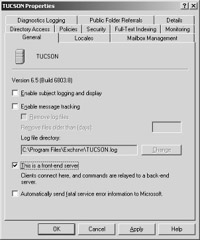Front-EndBack-End Servers
Front-End/Back-End Servers
Between the Exchange store architecture and the Internet access protocols lies a layer called the Exchange Interprocess Communication Layer (EXIPC), now known as the epoxy layer, which is an efficient, asynchronous shared area in memory to which both the Store.exe process and the IIS protocols can read and write. This queuing layer permits information to be exchanged very quickly between the IIS protocols that run inside the Inetinfo.exe process and the Store.exe process. The epoxy layer uses shared memory to communicate between these processes and is optimized for small packet communication.
To keep track of the binding, connection to, and use of the epoxy layer’s queues, Exchange Server 2003 uses the Central Queue Manager. This manager is also responsible for unbinding and queue cleanup in the event of a catastrophic failure in the other process. Because the transport protocols are decoupled from the information store, we can implement a front-end/back-end architecture, which makes it possible to run some of the Internet protocols on different servers than the servers on which the store and the databases are running. The major advantage to this feature is the ability to scale Exchange for any installed base that is desired. To enable Exchange Server 2003 to act as a front-end server, you simply select a single check box on the General tab of the Exchange server’s property sheet in the Exchange System snap-in (Figure 2-16).

Figure 2-16: Enabling a server to act as a front-end server.
When this check box is not selected, the protocol DLLs, such as Pop3be.dll, Imap4be.dll, and Httpbe.dll, are loaded into memory. When the server is marked as a front-end server, these protocols are unloaded and front-end- specific DLLs are loaded into memory, such as Pop3fe.dll, Imap4fe.dll, and Httpfe.dll. To fully balance the load between client requests on front-end servers, you will need to use a DNS round-robin scheme (in which multiple IP addresses are assigned to one host name), Network Load Balancing (NLB), or third-party software.
EAN: 2147483647
Pages: 254